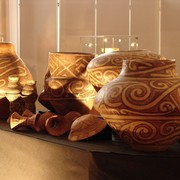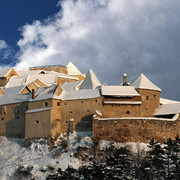In collaboration with Google, the artists from Bussana photographed the entire village, including more than 50 art studios. Artist village built on the ruins of a deserted medieval village, on a gentle hill, stands behind Sanremo to give a suggestive and unreal image of itself ...
In 1887, a huge earthquake struck Sanremos hinterland, seriously damaging Bussana. The place was abandoned. The village was no longer inhabited, until the settlement of the artist community from around the world, which began in the sixties, and brought it back to life, where it works and has its studios.
History: The earthquake of Wednesday, February 23rd, 1887 was a violent shock that determined the fate of Bussana. Numerous houses around the castle suffered heavy damage. Among the hardest-hit buildings were the old castle and the church of S. Maria delle Grazie (later of Sant 'Egidio), built in 1652 in the Baroque style instead of a medieval predecessor, from the end of the fourteenth century. The survivors, after living in temporary shelters for years, left the village and the city of Sanremo closed all accesses. Bussana remained a ghost town for about 60 years.
The Castle: Was originally a small fortified building in Bussana, the castle was probably built at the beginning of the twelfth century by Ottone the Count of Ventimiglia. Originally it had two towers for defense (of which only very few ruins, hard-to-interpret, remain today), with local presence functions and concrete manifestation of feudal power, but over time it suffered progressive expansion to gradually lose its defensive features and become more purely residential. Already in the second half of the thirteenth century, part of the building was uninhabited, and over the centuries, the abandonment of the fortified core became more evident; By the end of the fifteenth century, the interiors were already in ruins.
The Osteria: (Inn) Is a symbolic place where the confluence of the streets and the events of Bussana meet, where the circular structure of the village has its connection point. From here begins the path to ascend and leads to the lower part, where, from the earliest times, the heart of Bussana's artistic life has been created, where the first galleries and the first studios were created, where the art of the ancient buildings, destroyed by the earthquake, were brought back to life.
60's years: the reconstruction of the village. The history of the artistic community of Bussana begins at the end of the fifties, when the Turiner potter Mario Giani, also known as Clizia, visited the ruined village, completely abandoned at that time, and the idea of founding an international community of artists with a statute (a kind of small constitution to regulate the social relations between its members). The Bussana buildings were available to the community; but they were unable to claim ownership of a property, however to use for activities in performing arts. After three years of abandonment, the buildings had to be released to the community, which would place a later assignment. It was also forbidden to sell the products of their work. The place was then in a state of complete decay: completely free of urban infrastructure (water, electricity, telephone, sewage). Soon life came back to the village, craftsmen and artists from Italy and Europe started the restoration work, respecting the medieval town structure of the village. The materials used for the reconstruction were the tiles, stones and bricks recovered from the rubble.
90's years: Between the late eighties and early nineties, growth of the speculative real estate phenomenon. Originally, who left Bussana and the house he had restored, demanded a simple reimbursement of the costs incurred from what had often been a radical reconstruction of the building; but later the rise of the influx of artists and craftsmen into the village, led to the creation of a real estate market. In recent years, an increasing number of houses have been bought (but by whom and under what title, as the property, in Bussana, does not exist at all) by persons residing in Bussana, exclusively for tourist purpose. The result is so, in the total absence of rules, that it distorted the artistic vocation of the village.
Info: www.bussanavecchia.it

![Bussana Vecchia: the first pedestrian village in Italy, after Venice, to be imaged by Google's Street View. [Video and photo gallery] Bussana Vecchia: the first pedestrian village in Italy, after Venice, to be imaged by Google's Street View. [Video and photo gallery]](https://www.italyrivieralps.com/fileadmin/archivio/italyrivieralps/bussana1_01.png)















![Hanbury Gardens, itineraries for everyone all year round [Videos] Hanbury Gardens, itineraries for everyone all year round [Videos]](https://www.italyrivieralps.com/typo3temp/pics/g_a7708c6a79.jpg)





